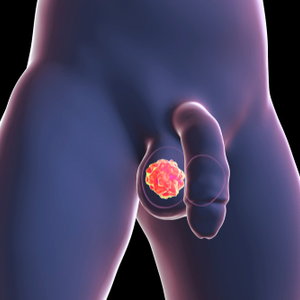
Testicular cancer at a glance
Testicular cancer is a malignant cancer of the testis and is one of the most common malignant tumours affecting men between the ages of 20 and 40. Men who suffered from undescended testicles, the so-called inguinal testicles, in their childhood are particularly affected. But genetic factors, precancerous cells in the testicles (TIN) and fertility problems also increase the risk of developing testicular cancer.
How can you prevent testicular cancer from developing?
Urologists recommend that men have regular scans of both testicles. If a man has an increased risk of developing testicular cancer due to his genetic disposition, for example, it is also advisable to have an annual ultrasound examination by a urologist. In this way, there is an increased chance that testicular carcinoma will be detected at an early stage of the cancer.
Testicular cancer often appears as a painless swelling and/or hardening of the testicle. Sometimes there may also be testicular pain, but this does not necessarily indicate testicular carcinoma. However, any painless swelling and/or induration should be clarified by an ultrasound examination by a urologist.
How is testicular carcinoma diagnosed?
Testicular cancer is usually diagnosed during an ultrasound examination. This can also be carried out as part of routine diagnostics, for example to clarify a fertility disorder. But also in the case of swollen lymph nodes in the abdomen or metastases in the lungs, the doctor will always carry out an examination of the testicles to rule out testicular carcinoma.
In addition to ultrasound findings, testicular carcinoma can also be diagnosed by abnormal blood values. In particular, the proteins and enzymes alpha-feto protein (AFP), human chorionic gonadotropin (HCG) and/or lactate dehydrogen (LDH) are found to be increased in testicular cancer, but do not necessarily indicate testicular carcinoma. Slightly elevated AFP values also occur in smokers, while LDH values can also be elevated after physical work. However, if the blood values do not show any irregularities, this does not mean that there is no testicular carcinoma. Nevertheless, a doctor will not dispense with any blood test, as the laboratory values always provide information about the type of testicular cancer and play an important role in the selection of the therapy procedure.
How is testicular carcinoma treated?
Testicular carcinoma is usually removed surgically. This involves putting the patient under anaesthetic and making an incision in the groin to expose the spermatic cord and testicle on the affected side of the body. The urologist looks at the exposed testicle to see if it is a malignant tumour. If in doubt, a frozen incision can be made and a tissue sample taken. If the tumour turns out to be malignant, the affected testicle and spermatic cord are removed. However, tissue is also taken from the healthy testicle by means of a small incision in the scrotum in order to exclude precancerous forms or to treat them at an early stage. The now empty scrotum can be filled with a testicular prosthesis implant. The testicular prosthesis implantation consists of a silicone cushion which is adapted to the size of the healthy testicle and serves exclusively cosmetic purposes.
The duration of the operation is usually between 60 and 90 minutes. The patient remains in hospital for about 2 to days. If it is found during the operation that the testicular carcinoma has already spread to many metastases, chemotherapy is continued after the operation. If the tumour is quite small, it may not be necessary to remove the entire testicle.
Young men in particular, for whom family planning has not yet been completed, should be informed in detail about so-called cryopreservation. This is the freezing of sperm, which can be stored in the freezing depot for an unlimited period of time and used for fertility treatment. Cryopreservation is usually carried out before surgery, or at the latest before radiotherapy or chemotherapy. In Germany, however, the costs of cryopreservation are not normally covered by statutory or private health insurance and therefore fall on the patient. However, changes in the law are planned.
Aftercare of testicular cancer
The testicles are responsible for the production of male hormones (testosterone) and the production of sperm. These two functions can also be performed by only one healthy testicle. However, it is advisable to check the testosterone levels in regular follow-up examinations in order to diagnose a possible testosterone deficiency at an early stage. If necessary, testosterone supplementation with gel preparations or depot injections can be ordered.
Within the follow-up treatment, a CT scan is performed in addition to an ultrasound scan, as this is the most accurate method to detect metastases. Since the patient is exposed to a not inconsiderable radiation load during the CT, this necessary examination is kept to a minimum. Otherwise, there is a risk of developing so-called second malignancies (radiation-induced tumours).
Cure prospects
In the first two years after the treatment of a testicular carcinoma, there is a high probability that the cancer will recur. This is why the regular check-ups are usually at three months. During this check-up, not only is an ultrasound of the healthy testicle performed, but blood is also taken. After the 5th year of follow-up care, only an annual examination by a urologist takes place if the course of the disease is inconspicuous.
